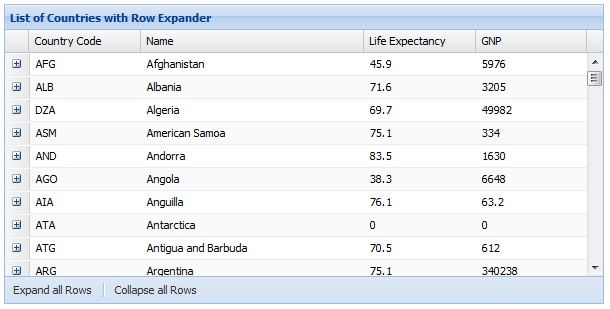
by sorting a Detail Grid), that state will be kept if you close the Parent Row and then open the Parent Row again. If you change the state of a Detail Grid (e.g. All the Detail Grids allow moving and sorting columns. Gb. The Master Grid has property keepDetailRowsCount2 which sets the number of Details Rows to keep to 2. There is no cell renderer configured, so the grid just places the text for the group into the cell, there is not expand / collapse functionality. All rows that are not this group are blank. Below are two examples presenting the hierarchy in different. The column Country Group - No Renderer configures the grid to put the Country group data only into this column by setting showRowGroupcountry. The callback must return a string representing the route, with each element specifying a level of the tree. Using the GridOptionBuilder, this would look something like: When providing tree data to the grid, you will need to implement the gridOptions.getDataPath (data) callback to tell the grid the hierarchy for each row. Use this event if you want to auto resize columns based on their contents.
AG GRID EXPAND ROW ON CLICK CODE
I don’t know javascript well enough to tell you what that code should be, though. Fired the first time data is rendered into the grid. This option can take some JsCode that will be executed whenever a cell is clicked. The closest thing to what you are looking for is probably the onCellClicked grid option. To expand all row groups set groupDefaultExpanded -1. By default groupDefaultExpanded 0 which means no groups are expanded by default. The callback is called for each Detail Grid and sets the rows to display in each Detail Grid.Hey Kiran, I have a couple ideas for hacks for this. To open all groups down to a given group level use the groupDefaultExpanded grid option as shown below: In the snippet above, all country row groups will be expanded by default as groupDefaultExpanded 1. Provide a callback via the Detail Cell Renderer* parameter getDetailRowData. This contains configuration for the Detail Grid such as what columns to display and what grid features you want enabled inside the Detail Grid. The API has expandAll and collapseAll: api.expandAll () api.collapseAll () Note that due to the crappy architecture of AG Grid the expansion state (along with row selection etc) is lost if the row data changes or the grid is re-mounted/re-rendered.

Set the Detail Cell Renderer* parameter detailGridOptions. //rowExpandedStateChanged is fired for each row as its expanded.

This tells the grid to use the Group Cell Renderer which in turn includes the expand / collapse functionality for that column. Set the Cell Renderer on one Master Grid column to agGroupCellRenderer. For example, the callback for the cellClicked event is gridOptions.onCellClicked. The name of the callback is constructed by prefixing the event name with on.

You register callbacks for these events through the GridOptions interface. This tells the grid to allow expanding rows to display Detail Grids. This is a list of the events that the grid raises. The example below shows a simple Master / Detail with all the above configured. masterDetail = true // the first Column is configured to use agGroupCellRenderer this.

Note that this example uses ag-Grid Enterprise as it uses grouping. Then the grid is told to reposition all rows again via calling api.onRowHeightChanged(). Zimbabwe Leaf Rows: The row height is set directly on the rowNode.
AG GRID EXPAND ROW ON CLICK FULL
You can check the full icon list in the GitHub repository. You will need to expand a group with swimming (eg America) and the grid works out all row heights again. The icons should be 14x14px sized SVG files. Master / Detail can be enabled using the masterDetail grid option with detail rows configured usingĭetailCellRendererParams as shown below: // enable Master / Detail this. The easiest way to replace the entire icon set is to change the ag-icons-path Scss variable to point to a directory with your set of icons.


 0 kommentar(er)
0 kommentar(er)
